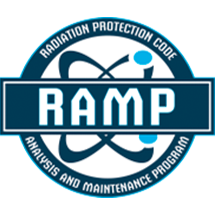Version 5.0.4
Released March 2024
Updates:
- A bug was discovered that made it so that the activity of daughter products was not being counted when the nuclides in the initial inventory decayed. The decay process in RADTRAD would still remove and add activity from parent and daughter nuclides, but only if they were in the initial inventory. The fix allows RADTRAD to automatically add daughters to the inventory. To prevent the inventories and output files from becoming excessively large, only the first daughter in each decay chain is automatically added to the inventory. Nuclides can be added to the inventory with an initial activity of 0 if the user is interested in seeing the contribution of adding in a specific daughter.
- The ability to limit the minimum time step size was included when using the default time step (this capability was already in place for the adaptive time stepping option). The default timestep size is reduced based on the smallest half-life in the inventory. If a nuclide with a short half-life is included, then the timestep size will be very small. Allowing the user to set a minimum time step size prevents it from getting smaller than wanted or expected. The ability to set the minimum timestep has also been included in the SNAP plugin.
- A bug was discovered that showed that the max 2-hour dose was not being correctly captured when the max 2-hour dose occurred later than 24 hours into the run. The bug was caused by an error with the timestep and corrected.
- The gamma energy and frequency can now be added to the .nix file for every nuclide in the following form:<gammaDecay name=”gamma 1” energy=”1.51E-1” frequency=”7.55E-1”>. This addition is meant as a steppingstone to build off to output gamma spectra for users.
- A change was made to the output to include the mass of each nuclide for every reported timestep.
- The error information will not be included in the plot file by default when using adaptive time stepping and the –rgtest argument. This change in default allows the plot files between the tests using adaptive time stepping and the tests using the external time step file from the adaptive time step tests to be identical and confirms that state is being preserved correctly. The error information can still be reported in the plot file of a regression test if the –c or –calculate_error commands are used along with the –rgtest command.
- The compiler for RADTRAD was updated to Java 8 rather than the previous Java 6. The new compiler allowed for newer code features that helped with the changes above. Java 8 is now recommended by Java and Java 6 is becoming more outdated. The change in compiler did not affect the regression results.
